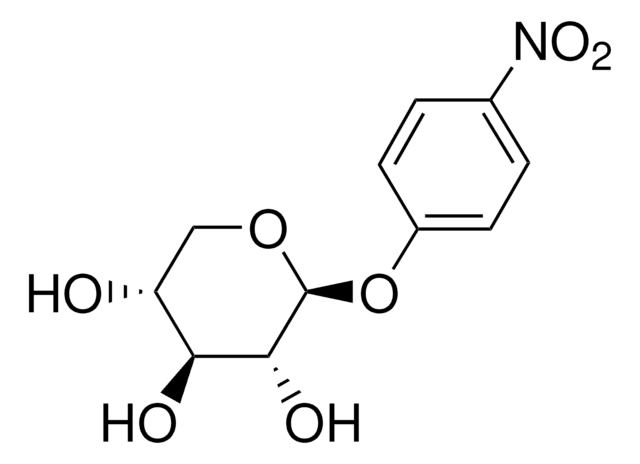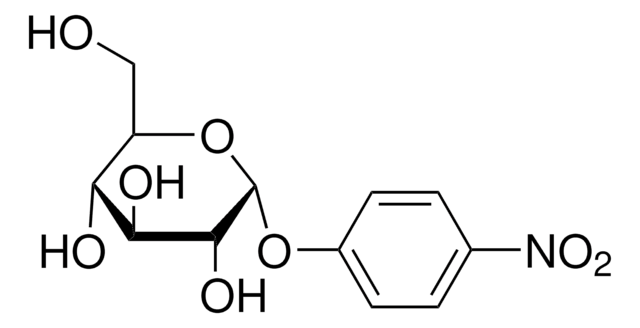N3512
4-Nitrophenyl α-L-arabinopyranoside
arabinosidase substrate, ≥98% (HPLC), powder
Synonym(s):
4-Nitrophenyl alpha-L-arabinopyranoside, p-Nitrophenyl alpha-L-arabinopyranoside
Sign Into View Organizational & Contract Pricing
All Photos(2)
About This Item
Empirical Formula (Hill Notation):
C11H13NO7
CAS Number:
Molecular Weight:
271.22
MDL number:
UNSPSC Code:
12352204
PubChem Substance ID:
NACRES:
NA.32
Recommended Products
Product Name
4-Nitrophenyl α-L-arabinopyranoside, arabinosidase substrate
Quality Level
Assay
≥98% (HPLC)
form
powder
solubility
ethanol: water (1:1): 19.60-20.40 mg/mL
storage temp.
−20°C
SMILES string
OC1COC(Oc2ccc(cc2)N(=O)=O)C(O)C1O
InChI
1S/C11H13NO7/c13-8-5-18-11(10(15)9(8)14)19-7-3-1-6(2-4-7)12(16)17/h1-4,8-11,13-15H,5H2
InChI key
MLJYKRYCCUGBBV-UHFFFAOYSA-N
Application
4-Nitrophenyl α-L-arabinopyranoside may be used: as a 4-nitrophenyl-glycoside substrate to study the substrate activities of TlAbf51 by determining the arabinofuranosidase (Abf) activity in standard conditions. It may also be used to determine the activity of α-L-arabinofuranosidase spectrophotometrically.
Storage Class Code
11 - Combustible Solids
WGK
WGK 3
Flash Point(F)
Not applicable
Flash Point(C)
Not applicable
Personal Protective Equipment
dust mask type N95 (US), Eyeshields, Gloves
Choose from one of the most recent versions:
Already Own This Product?
Find documentation for the products that you have recently purchased in the Document Library.
Customers Also Viewed
Tao Tu et al.
Microbial cell factories, 18(1), 138-138 (2019-08-21)
The development of sustainable technologies for plant cell wall degradation greatly depends on enzymes with hydrolytic activities against carbohydrates. The waste by-products of agricultural cereals are important biomass sources because they contain large amounts of saccharides. Achieving efficient debranching and
Our team of scientists has experience in all areas of research including Life Science, Material Science, Chemical Synthesis, Chromatography, Analytical and many others.
Contact Technical Service








